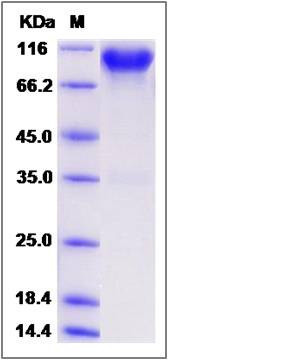Rhesus FGFR4 / FGF Receptor 4 Protein (Fc Tag)
FGFR4
- 100ug (NPP2927) Please inquiry
| Catalog Number | P90134-C02H |
|---|---|
| Organism Species | Rhesus |
| Host | Human Cells |
| Synonyms | FGFR4 |
| Molecular Weight | The recombinant rhesus FGFR4 comprises 589 amino acids and has a calculated molecular mass of 65.6 KDa. |
| predicted N | Leu 22 |
| SDS-PAGE |  |
| Purity | > 95 % as determined by SDS-PAGE |
| Protein Construction | A DNA sequence encoding the rhesus FGFR4 (Met1-Asp369) (XP_001087243.1) was expressed with the Fc region of mouse IgG1 at the C-terminus. |
| Bio-activity | Measured by its binding ability in a functional ELISA. 1. Immobilized human FGF18-His (P 13206-H08H) at 10 μg/ml (100 μl/well) can bind cynoFGFR4-Fc (P 90134-C02H) with a linear range of 0.25-2.0 μg/ml. 2. Immobilized human FGF basic (P 10014-HNAE) at 10 μg/ml (100 μl/well) can bind cynoFGFR4-Fc (P 90134-C02H) with a linear range of 0.03-0.25 μg/ml. |
| Research Area | Cancer |Invasion microenvironment |Angiogenesis |Growth Factor & Receptor |Receptor Tyrosine Kinase (RTK) |
| Formulation | Lyophilized from sterile PBS, pH 7.4 1. Normally 5 % - 8 % trehalose and mannitol are added as protectants before lyophilization. Specific concentrations are included in the hardcopy of COA. |
| Background | Fibroblast growth factor receptor 4 (FGFR4) also known as CD334 antigen or tyrosine kinase related to fibroblast growth factor receptor, is a member of the fibroblast growth factor receptor family, where amino acid sequence is highly conserved between members and throughout evolution. FGFR family members differ from one another in their ligand affinities and tissue distribution. A full-length representative protein would consist of an extracellular region, composed of three immunoglobulin-like domains, a single hydrophobic membrane-spanning segment and a cytoplasmic tyrosine kinase domain. The extracellular portion of FGFR4/CD334 interacts with fibroblast growth factors, setting in motion a cascade of downstream signals, ultimately influencing mitogenesis and differentiation. FGFR4/CD334 preferentially binds acidic fibroblast growth factor and, although its specific function is unknown, it is overexpressed in gynecological tumor samples, suggesting a role in breast and ovarian tumorigenesis. FGFR4/CD334 signaling is down-regulated by receptor internalization and degradation; MMP14 promotes internalization and degradation of FGFR4/CD334. Mutations in FGFR4/CD334 lead to constitutive kinase activation or impair normal FGFR4 inactivation lead to aberrant signaling. |
| Reference |
